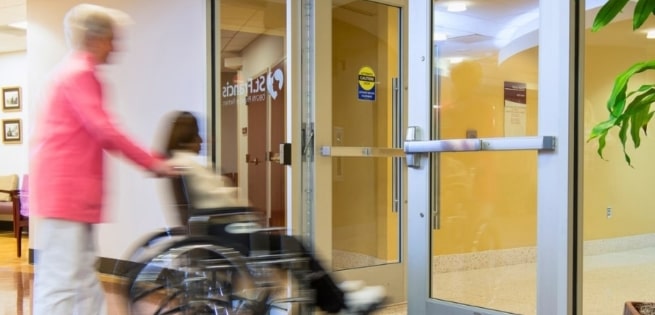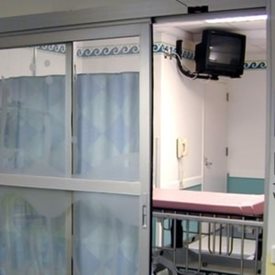Automatic Doors: Enhancing Safety and Convenience in Hospital Design
October 31, 2023
In the intricate world of healthcare facility design, where every detail can impact patient outcomes and operational efficiency, the choice of door systems may not seem like the most critical decision. However, the selection of automatic doors can significantly influence the functionality, safety, and accessibility of a healthcare setting. In this blog, we will delve into the pivotal role of automatic doors in hospital design and explore how they contribute to improved accessibility, infection control, safety, energy efficiency, and operational efficiency.
Improved Accessibility for Patients and Visitors

Reducing physical barriers for patients with mobility challenges: In healthcare settings, providing unhindered access to patients is paramount. Automatic doors, such as swinging or sliding doors, offer a hassle-free entry and exit experience for individuals with mobility challenges, including those using wheelchairs, crutches, or mobility aids. This enhances their independence and overall well-being.
Enhancing ease of access for wheelchair users: Automatic doors, equipped with accessible push-button systems, ensure that patients in wheelchairs can comfortably enter and exit the hospital. This not only complies with accessibility regulations but also shows the hospital's commitment to inclusivity.
Ensuring safe and convenient entry for people with strollers or carrying heavy loads: Parents with strollers, caregivers with medical equipment, and those carrying heavy loads benefit from automatic door systems. These doors reduce the physical strain and make entering the hospital a more convenient experience.
Facilitating entry for elderly individuals with limited physical strength or stability: Elderly patients often struggle with traditional doors due to limited physical strength or stability. Automatic doors with motion sensors or push-button activation provide a safer and more comfortable means of entry.
Creating a welcoming environment for visitors with varying abilities: In healthcare facilities, not only patients but also their visitors require easy access. Automatic doors create a welcoming environment, ensuring that everyone, regardless of their abilities, can navigate the facility comfortably.
Maintaining Hygiene and Infection Control
 Minimizing the spread of germs through touchless entry: Healthcare facilities are hotspots for potential infections. Automatic doors equipped with motion sensors or touchless access control reduce the spread of germs, as they eliminate the need for patients, staff, and visitors to touch door handles.
Minimizing the spread of germs through touchless entry: Healthcare facilities are hotspots for potential infections. Automatic doors equipped with motion sensors or touchless access control reduce the spread of germs, as they eliminate the need for patients, staff, and visitors to touch door handles.
Mitigating cross-contamination risks at high-traffic entrances: Hospitals have high foot traffic, especially in public entrances. Automatic doors maintain a barrier between clean and potentially contaminated areas, reducing the risk of cross-contamination.
Promoting hand hygiene compliance among staff and visitors: Automatic doors encourage hand hygiene compliance. By minimizing the need for door handle contact, these systems promote cleaner hands among staff and visitors, further reducing the risk of infection spread.
Enhancing isolation protocols and reducing the risk of airborne transmission: In healthcare settings, isolation rooms or clean rooms are critical for patients with contagious diseases. Automatic doors with airtight seals help maintain isolation protocols by minimizing the risk of airborne transmission.
Supporting a clean and sanitized environment for improved patient outcomes: Automatic doors are easier to clean and maintain. This helps in keeping the environment clean, which is crucial for patient recovery and infection control.
Enhancing Safety and Security Measures
Preventing unauthorized access to restricted areas: Hospital design requires precise control over who can access certain areas. Automatic doors can be integrated with access control systems to prevent unauthorized entry into restricted areas.
Streamlining emergency evacuation and response procedures: In emergencies, such as fires or evacuations, automatic doors facilitate swift and controlled egress. These systems can be programmed to open automatically during emergency situations, ensuring the safety of patients and staff.
Improving surveillance and monitoring capabilities: Hospitals rely on security and surveillance systems to ensure patient safety. Automatic doors can be integrated with these systems, providing better control over entry and exit points and enhancing security monitoring capabilities.
Ensuring compliance with regulatory requirements for door operation: Healthcare facilities must adhere to specific regulations and standards. Automatic door systems can be designed to comply with these requirements, reducing the risk of non-compliance.
Facilitating controlled access for staff, patients, and visitors: Automatic doors offer the flexibility to establish controlled access points within the facility, ensuring that only authorized personnel can enter certain areas, such as laboratories or operating rooms.
Improving Energy Efficiency and Cost Savings
Reducing energy consumption through optimized door operation: Automatic doors are energy-efficient. They open and close swiftly, reducing the loss of conditioned air and contributing to energy savings, a vital aspect in healthcare facility sustainability efforts.

Enhancing thermal insulation and climate control within the premises: Automatic doors, when closed, provide excellent thermal insulation, contributing to stable indoor temperatures. This is crucial for maintaining the comfort of patients and conserving energy.
Reaping financial benefits through decreased utility expenses: Energy-efficient automatic door systems lead to reduced utility expenses, which can translate to significant cost savings for healthcare facilities in the long run.
Contributing to sustainability and environmental conservation efforts: Hospitals are increasingly adopting sustainable practices. Automatic doors, with their energy-efficient operation and potential for reduced energy consumption, align with these green initiatives.
Maximizing cost-effectiveness in hospital facility management: Automatic doors require less maintenance than traditional doors, resulting in cost savings over time. They are a cost-effective choice for hospital facility management.
Implementing User-Friendly and Efficient Entry Systems
Incorporating automated features for seamless entry and exit: Automatic doors are designed for seamless entry and exit. They open and close smoothly, enhancing the overall patient and staff experience.
Customizing door settings to meet specific hospital workflow requirements: Hospitals have unique workflows and requirements. Automatic doors can be customized to suit the specific needs of the facility, whether it's a busy emergency department or a quiet patient room corridor.
Providing hassle-free access for medical equipment and supplies transportation: The movement of medical equipment and supplies is a crucial aspect of hospital operations. Automatic doors ease the transportation of these items, contributing to the efficiency of healthcare delivery.
Integrating advanced technologies such as motion sensors and access control: Automatic doors can be equipped with advanced technologies, including motion sensors, facial recognition, and access control systems. These features enhance security and access control within the hospital.
Improving overall operational efficiency and patient flow: Automatic doors contribute to the overall efficiency of the hospital. They ensure smooth patient flow, reduce bottlenecks, and enhance the patient experience, ultimately leading to better healthcare delivery.
The Importance of Automatic Doors in Hospital Design
In conclusion, the incorporation of automatic doors in hospital design is more than just a convenience—it's a fundamental element that impacts accessibility, infection control, safety, energy efficiency, and overall operational efficiency. Healthcare facilities that prioritize the installation and maintenance of automatic door systems are not only creating a more patient-friendly environment but also adhering to the high standards of the healthcare industry. These doors are not just an entrance; they are a gateway to improved healthcare experiences and outcomes.
ABOUT DOOR SERVICES CORPORATION
Your expert partner for pedestrian door service and installation, our company was built on quality products and long-term customer partnerships. We are a member of the American Association of Automatic Door Manufacturers. Our AAADM certified technicians have over 50 years of product knowledge. We service and repair all doors and windows models of all automatic door manufacturers.24/7 emergency service is available to meet your after hour needs in our designated coverage areas:
- Advanced Door Automation - North Carolina and east to the coastal regions
- Advanced Door Service - Eastern Pennsylvania, Virginia, DC, Baltimore and Northern Georgia
- Allegheny Door Enterprises - Western Pennsylvania and West Virginia
- Automatic Door Enterprises - Philadelphia, Pennsylvania and surrounding areas
- Del-Mar Door Service - Delaware
- Door Controls - Louisiana
- Door Control, Inc. - Maine, New Hampshire, Vermont and Northeast New York
- Door Concepts, Inc. - Rhode Island and Eastern Massachusetts
- Eastern Door Service - New Jersey
- Keystone Automatic Door Enterprises - Northern Pennsylvania
- Texas Access Controls - Dallas, Houston, Austin and Corpus Christi, Texas areas
- Horton Automatics of Ontario - Ottawa Valley and Southern Ontario, Canada
- Pasco Doors – Southern California
